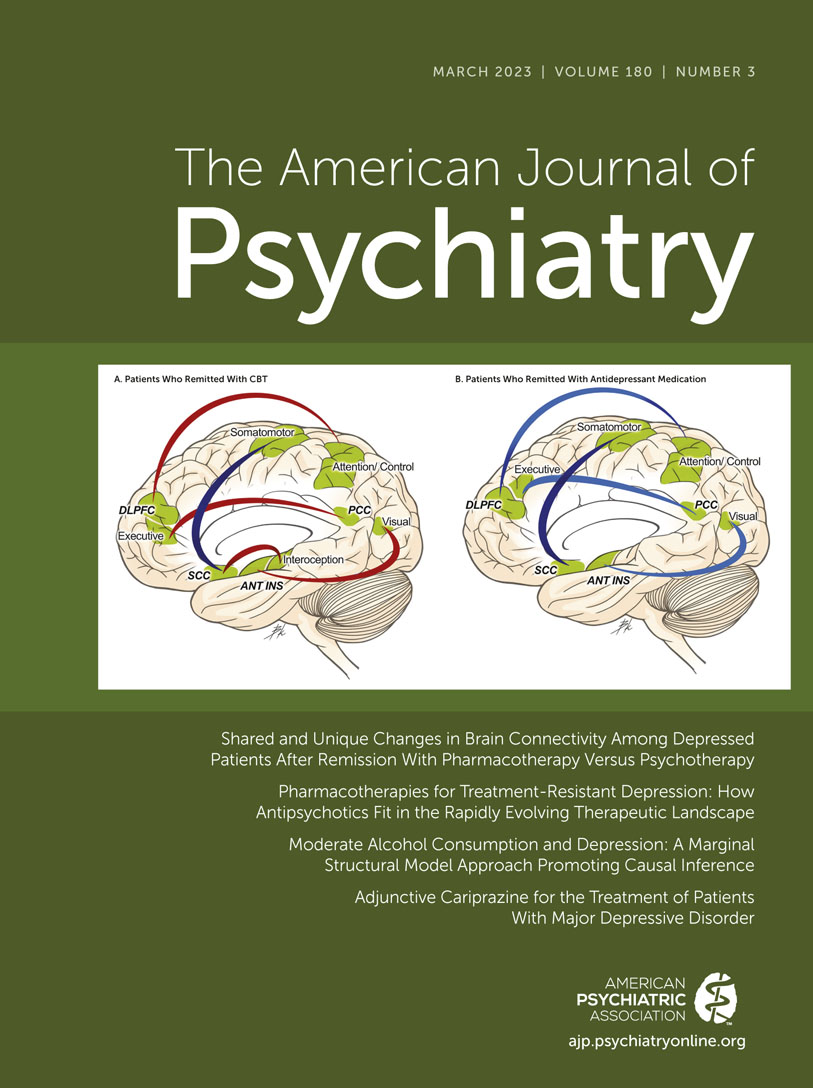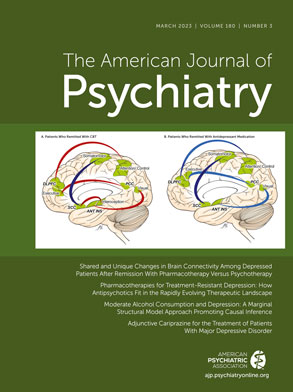The article by Sachs and colleagues (
1) in this issue of the
American Journal of Psychiatry describes the main findings of a randomized controlled trial of the second-generation antipsychotic (SGA) cariprazine as an adjunctive treatment for patients with major depressive disorder (MDD). Because not all of the participants had received two or more adequate trials of therapy with standard antidepressants in the current episode, the sample does not technically meet regulatory criteria for treatment-resistant depression but does represent the pool of depressed patients who are considered for second- or third-line treatment options. This paper is important for a number of reasons. First, MDD is a common and potentially disabling condition that is recognized as one of the world’s greatest public health problems (
2–
4). Second, although prompt recognition and vigorous treatment is inarguably the best strategy to reduce the profound suffering and illness burden attributable to MDD, many depressed people—perhaps up to 40%—do not respond to sequential trials of standard antidepressant medications (
5,
6). As a result, people with more difficult-to-treat depressive episodes account for a disproportionately large share of the staggering socioeconomic costs associated with this illness (
4), and the identification of safe and effective alternative treatment options for these patients continues to be a priority for treatment research (
7). Third, because the U.S. Food and Drug Administration (FDA) considered the results of this study to be pivotal in their recent review and approval of cariprazine for this indication (
https://www.clinicaladvisor.com/general-medicine/top-december-2022-fda-approvals/), it behooves prescribers to be familiar with these data.
Dating back to the publication of the main findings of the Sequenced Treatment Alternatives to Relieve Depression study (
5), there has been steadily increasing use of adjunctive treatment strategies in lieu of simply switching to a different antidepressant medication. This change in practice patterns has no doubt been fostered by accumulating evidence that a number of SGAs are effective as adjuncts following nonresponse to selective serotonin reuptake inhibitors or other first-line antidepressants (
8,
9). Perhaps of greatest relevance to our patients, adjunctive therapy with an SGA tends to be easier to implement than adopting switching strategies because there is no need for tapering the ineffective medication or cross-titration, and when the SGA is effective, clinically meaningful benefits are often observed within the first few weeks of therapy (
8). Cariprazine is the fifth SGA to receive FDA approval as adjunctive therapy for MDD, joining two of the relatively older SGAs (olanzapine and quetiapine) and two SGAs (aripiprazole and brexpiprazole) that share dopamine partial agonism as a presumed mechanism of action. Similar to other SGAs when studied as adjunctive therapies (
8), the antidepressant efficacy of adjunctive cariprazine is evident at about one-half of the dosage commonly used to treat mania or schizophrenia. In the trial of Sachs and colleagues, for example, efficacy was established in the group receiving 1.5 mg/day but not in the group receiving 3.0 mg/day. However, the actual difference in symptom improvement between the groups was negligible. In the other pivotal randomized controlled trial of adjunctive cariprazine therapy, patients receiving flexibly titrated therapy at 2.0–4.5 mg/day obtained significant improvement, whereas the group treated with 1.0–2.0 mg/day did not (
9). Nevertheless, as lower adjunctive dosages of cariprazine are likely to result in better tolerability, dosages above 1.5 mg/day should be reserved for patients who have few side effects but insufficient benefit after 4–6 weeks of therapy.
Much work remains to be done to establish the best place for cariprazine in our treatment algorithms and pharmacy benefit tiers. As is still the case with other SGAs when prescribed as adjuncts to antidepressants, the field requires better data on longer-term treatment outcomes to determine the optimal duration of therapy to achieve the desired efficacy. We also need more comprehensive safety data during longer-term therapy so that the risks of weight gain, other metabolic complications, and tardive dyskinesia can be more accurately gauged. Meanwhile, potential clinical characteristics that might differentiate cariprazine from other SGAs include a relatively novel mechanism of action, a low risk of significant weight gain, and a low rate of daytime sedation. Of course, cost-effectiveness will also be a concern, as branded formulations of SGAs are substantially more expensive than generically available alternatives. Therefore, a skeptic with an eye focused on pharmacy expenditures might ask “Do we really need another SGA approved for this indication?” I believe the answer is “yes” in part because individual differences in drug response make it useful to have more than one option within classes or subclasses of medications. Furthermore, assessments of cost-effectiveness are ephemeral as the time period for market exclusivity is relatively short-lived. Although data from head-to-head randomized controlled trials are ultimately needed to make more precise comparative judgments of benefits, risks, and cost-effectiveness, FDA approval of cariprazine for adjunctive treatment of MDD is a welcome step in treatment development.

